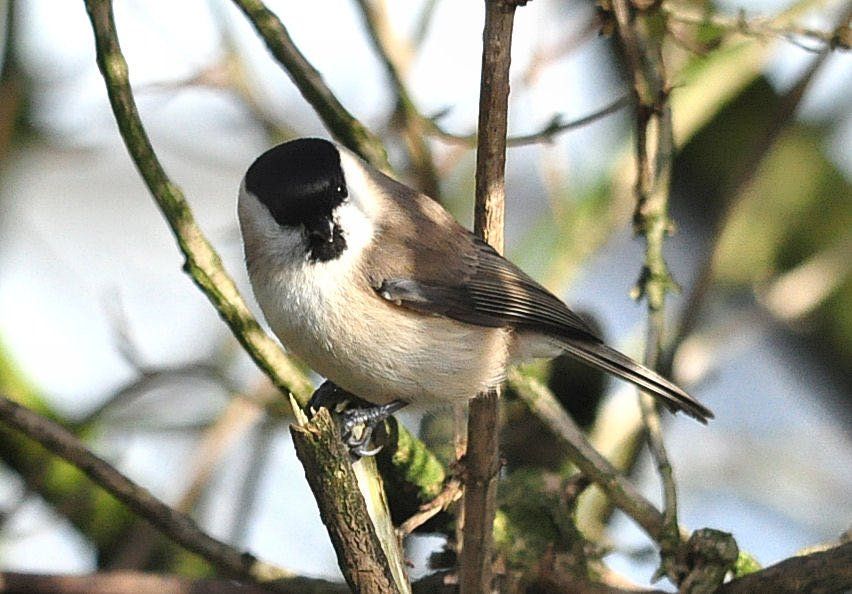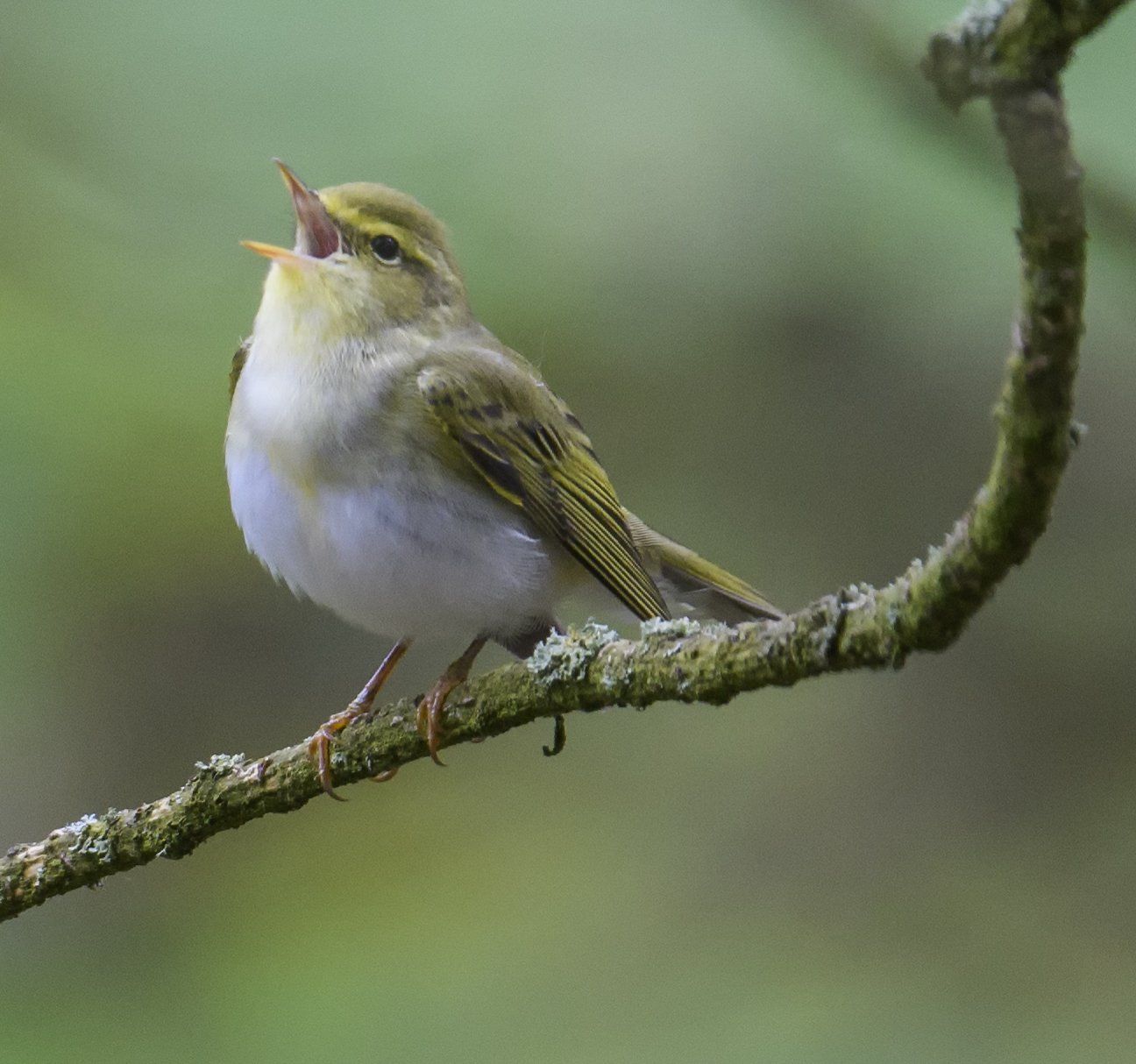CETTI’S WARBLER
Cettia cetti
Rare passage visitor.
2016
- A bird recorded at Snaygill on 31st October was a new species for the Group. However, it has been anticipated as the species has been seen at Rodley Nature Reserve in recent years and breeds in the Wakefield area.
DARTFORD WARBLER
Sylvia undata
Vagrant
1989 - The discovery of this bird at Lindley Wood Reservoir on 23rd April was probably the most unexpected event of the year. Many members enjoyed excellent views of this rarity on pre-work visits until it departed on 26th April. On plumage and bare-part features, the bird appeared to be a male of the main continental race S. u.undata
rather than a vagrant from the highly sedentary breeding population in southern England and it was probably a first-summer individual judging by the very worn tail feathers, presumably retained from juvenile plumage. This bird is believed to constitute the most northerly record of the species to date.
2005
- After sixteen years, the Group’s second record was established by a field worker carrying out a moorland survey on Rombald’s Moor on 8th June.
GRASSHOPPER WARBLER Locustella naevia
Uncommon passage migrant and occasional breeder
2015
- The ten records are related to five birds. The first was trapped and ringed on Baildon Moor on 22nd April and the second was heard on five occasions from 10th May until 5th July at Stockbridge. In early June, a reeling bird was heard at Timble Ings and in July another was located in dense bushes by Harden cricket pitch. The final record was on the northern edge of Soil Hill on 23rd August.
2016
- Thirteen records from seven northern sites and a single confirmed breeding record suggests the species enjoyed a good year in our recording area. Perhaps most interesting are the ongoing sightings coming from the Shipley Glen area with a bird noted on 30th April in the same location where previous records have come from. Nearby, reeling birds were first seen and heard near Pennythorn in June and later carrying food to a nest amongst heather. This single breeding record was the first in the Group area for six years. Reeling birds were heard in June at Stainburn Plantation and in July at Stockbridge NR, near Shipley Glen and at Otley Wetland where on the 23rd a bird was caught in a mist-net.
2017
- Birds were heard at Yeadon Tarn between 23rd and 30th April, Timble Ings on 25th May, Tong Park on 17th June, Glovershaw on 9th July and Leeshaw on 14th August. Successful breeding was reported for the second successive year: at Sandwith Moor.
2018
- In a remarkable record year, at least 18 birds were seen or heard at nine general areas, all on or near moorland, between early May and mid-August. These were around Baildon Moor and Barden, Farnhill and Rombald’s Moors, Timble Ings and Askwith, Beamsley and Sandwith Moors, and Thornton Moor. However, unlike 2017, there were no breeding records.
WOOD WARBLER
Phylloscopus sibilatrix
Uncommon migrant breeder/occasionally on passage
2013
- There was no positive improvement on the extremely bleak picture painted in 2012. Only Strid Woods held out any prospect of breeding pairs and, though one couple were watched, no evidence of a favourable outcome was forthcoming. During spring, single males had been seen at Burley, Heber’s Ghyll , St. Ives and once more in Shipley Glen, where a male sang for a few days before, alas, departing.
2014
- A male bird was located in Low Wood on 24th April and there was another at Ogden Reservoir in late June. There were also records of a singing male in Cottingley Wood in May and June. In May two males were seen at Strid Wood, and at Heber’s Ghyll snatches of song were heard on a few occasions. None these spring sightings resulted in any evidence of breeding, though during June a pair was definitely identified in Strid Wood. In August, a bird was seen on Pennythorn Hill, Baildon and another was at the top of Heber’s Ghyll, both in mixed flocks.
2015
- Birds were reported at three locations: St Ives, where males were seen on 26th April and again at the end of May, Dob Park, where another was heard on 28th June, and Heber’s Ghyll, where three were present at the beginning of June (MD, MS, WNS). Unfortunately, there were no records from Strid Wood, where this species has always been present. There were also no reports of breeding.
2016
- Still no real signs of status improvement for this delightful warbler. In fact whilst records came from three sites the vast majority came from just one, its stronghold Strid Wood where on 28th April the first bird of the year burst into song. By 5th May this increased to five, and sightings continued from the site until 3rd July when a single was observed. However, there was no evidence of breeding. A final record was a passage bird at John o’Gaunt’s Reservoir on 18th August.
2017
- Only two pairs were reported from the regular Strid Wood, but birds were also seen in Cottingley Woods, St. Ives, and near Thruscross, and there was apparently attempted breeding at Heber’s Ghyll and Shipley Glen. However, no successes were recorded here or elsewhere.
A Wood Warbler in Heber's Ghyll, Ilkley
photo: Keith Allen
2018 - With one exception, birds returned to the same locations as last year: Cottingley Woods, Heber’s Ghyll, St. Ives, Strid Wood and near Thruscross. Two singing males were present at most of them, but there was no indications of breeding.
LESSER WHITETHROAT
Sylvia curruca
Increasingly uncommon migrant and passage visitor
2013
- Just one record of this increasingly uncommon species. There were no records from the previously reliable sites in South Bradford, but a bird was seen and heard on 30th April at Lindley Wood Reservoir.
2014
- The six records represent the best haul since 2011. The first was a bird in full song on 1st May at Wyke Beck, an old breeding site for this species. Four days later at Tong, another was seen and a further bird at Toad Holes Beck on 7th May. On the same day, also in the south of the area, there was a bird at Judy Woods. In Wharfedale there was a singing bird at Sun Lane NR on 3rd May, and on 21st June a bird was seen and heard at Knotford Nook.
2015
- It was another reasonable year with five records. The first was a male at Lindley Wood Reservoir on 1st May. At Sun Lane Nature Reserve another male was located on 9th May and four days later a third bird was heard at Toad Holes Beck, a site often associated with this species. On 3rd June a bird was reported on Guiseley Moor and the final record came from Low Moor, where a bird was located on 6th July.
2016
- Only three records received and all of probable passage birds. All these records came from the north of our recording area rather than the south, formerly a stronghold for the species.
In spring, a bird was near Bingley Grammar School on 9th May followed three months later by one at Pennythorn on 10th August and another at Slippery Ford on 6th September.
2017
- After a blank year there, singles were again seen in Low Moor on 10th May (Raw Nook Nature Reserve) and the 11th. Other reports were from Stockbridge on 30th April and John o’Gaunt’s Reservoir on 21st May.
2018
- Happily, the Low Moor area continues to produce a few birds, and this year singles at Toad Holes Beck and Caldene Fields were the prelude to proved breeding. Two other reports from Leathley and Otley Wetland were no doubt individuals on spring migration.
YELLOW-BROWED WARBLER
Phylloscopus inornatus
Vagrant
2012
- Undoubtedly the bird of the year, and a Group first, it was found at Ogden Reservoir on 29th September, and was seen by only a fortunate few later that day and on the 30th.
2013
- Remarkably, following the first ever report of one of these scarce warblers in the area in 2012, we received confirmation that another was seen and heard at Denton Hall on 6th October (SB et al). A sound recording was made and it can be heard on the Soundcloud website and the Group’s Blog.
2015
- During a national influx of this species, when 76 were recorded on Fair Isle at the end of September, there were two local records, both in October. The first was at Stockbridge on the 4th (SR) and the second on the 16th at Pool (AJ). These were the third and fourth records, the previous ones were in 2012 at Ogden Plantation and in 2013 at Denton Hall.
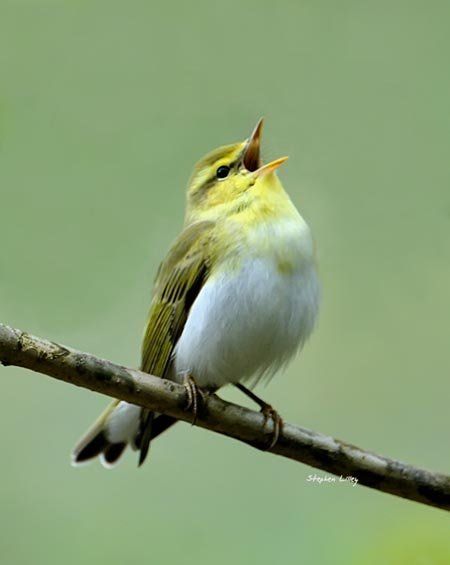
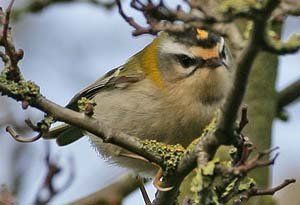
Wood Warbler in Strid Woods (left) photo: Stephen Lilley
A 2007 photo of a Firecrest at Dowley Gap photo: Sean Grey
FIRECREST
Regulus ignicapillus
Scarce passage visitor
1988
- There was a single bird at Knotford Nook on 29th October.
1989
- A bird in a tit flock visited a garden in the Toftshaw Lane of Bradford on 3rd and 5th November.
1993
- A bird found at Elland Gravel Pits on 21st November was the forerunner of a winter influx throughout Yorkshire. The bird remained until the year-end, but proved to be elusive.
1994
- A single bird was observed at Elland Gravel Pits on several days in early January including 8th and 15th. Another single bird visited a Liversedge garden on 3rd February.
1998
- A bird was seen associating with a flock of Goldcrests by the canal towpath at Hirst Wood on 11th December.
2002
- A bird was watched at Timble Ings Plantation on 13th October in a mixed tit and Goldcrest flock.
2003
- A male bird graced Dowley Gap sewage works from 20th – 23rd April and was seen by many group members. A bird was watched at very close range in the observer’s Addingham garden on 9th January. The eighth Group record.
2006
- A female of this attractive species was found on 19th December at Dowley Gap, an area which has proved attractive to these birds in the past. It was relocated three days later, was still present at the end of the year, and represents the 10th Group record.
2007
- The bird found at Dowley Gap in December, 2006 was last seen on 19th February.
2008
- Two birds were found, representing the 11th and 12th Group records. The first was in a garden at Yews Green, near Queensbury, on 16th March, and the second at East Riddlesden Hall on 16th November.
2010
- A bird found at Cragg Wood, Apperley Bridge, on 11th February was present until the 19th, and what was probably the same bird was relocated there on 6th March.
MARSH TIT
Parus paulustris
Scarce and decreasing resident
2009
- This increasingly uncommon species is particularly scarce in the south of the area, so a bird at Ogden Reservoir on 19th September was a notable find.
2010
- After nothing there last year, birds were again fairly frequently at Haverah Park, on 4th January, 27th February and 18th August (two birds), 17th March, 11th September and 14th December. A clearly different individual was at Bluberhouses on 13th October.
2011
- As in other recent years, almost all the records came from Haverah Park, where two birds were seen on 24th January, followed by probably one of these on the 30th, and on 1st and 24th February, and finally on 18th September. A bird near Fewston on 1st April broke the monopoly.
2012
- Even by recent standards, 2012 was a very poor year for this scarce tit. Haverah Park is now the only place likely to produce a record, and individuals were seen there on 14th February and 7th August.
2013
- Once more this tit was scarce, the only reliable place was at Haverah Park where an individual had been seen on 18th February. The following week, two birds were amongst a mixed flock of birds and on the 13th April another individual was noted. Away from here another single was recorded in Burley-in-Wharfedale on 16th April.
2014
- There were five records: in Wharfedale a bird was seen at Barden Scale on 24th August and one was near Knotford Nook on 25th June. The other reports all came from the Washburn. A bird visited the same Lindley feeder as the Willow Tit from 22nd January till 12th March and singles were seen in Scargill Woods on 30th June and 2nd September.
2015
- This year there were three records, which may refer to the same bird: a single seen at Lindley Trout Farm on 27th January, 11th and 20th March.
2016
- There was only one record: two birds at the now regular site below Scargill Reservoir on 24th September.
2017
- Birds appear to be just about hanging on in Haverah Park, where one was seen on 27th October. However, there was a welcome addition, with a single in Middleton Woods on 28th December.
2018
- The area round Haverah Park is now the only reliable site for this bird, and up to two were seen there in August and September. Elsewhere in the Washburn, singles were near Leathley in January and December.
WILLOW TIT
Parus montanus
Scarce and decreasing resident
2009
- Willow Tit is just about hanging on in the recording area, as just two reports testify. A bird was well seen on 3rd June in Haverah Park, and, remarkably, another spent almost the whole of August visiting a Riddlesden garden feeder.
2010
- Eight records of four birds is quite a good tally by the Group area’s current standards. The Riddlesden garden feeder used by a bird throughout August, 2009 was again patronised on 2nd January, but only for two hours, another visited a Menston garden during August and one was seen at the feeding station at Otley Wetland from 19th to at least 27th December . There was also a bird at Haverah Park on 8th April.
2011
- That there should be more records than for the previous species is largely down to one and occasionally two obliging and reliable birds attending feeders at Otley Wetland. At least one was seen on six occasions to 26th March, and on many dates from early July to the year end. Away from here, a bird in Denholme Clough on 4th September was a good find.
2012
- Thanks to a bird seen regularly at feeders at Otley Wetland, this species now produces more records than the preceding one, and the regular individual here was only absent from April to late July. Unusually, there was a sighting elsewhere: two birds at Timble Ings on 29th November.
2013
- A single bird, bearing a leg ring, was seen at feeders at Otley Wetland on a few occasions between 9th January and 8th February.
2014
- A single bird was watched as it made regular visits to feeders in Cinder Lane, Lindley during January and February.
2017
- A bird found at East Riddlesden Hall on 12th March was the first record since 2014.
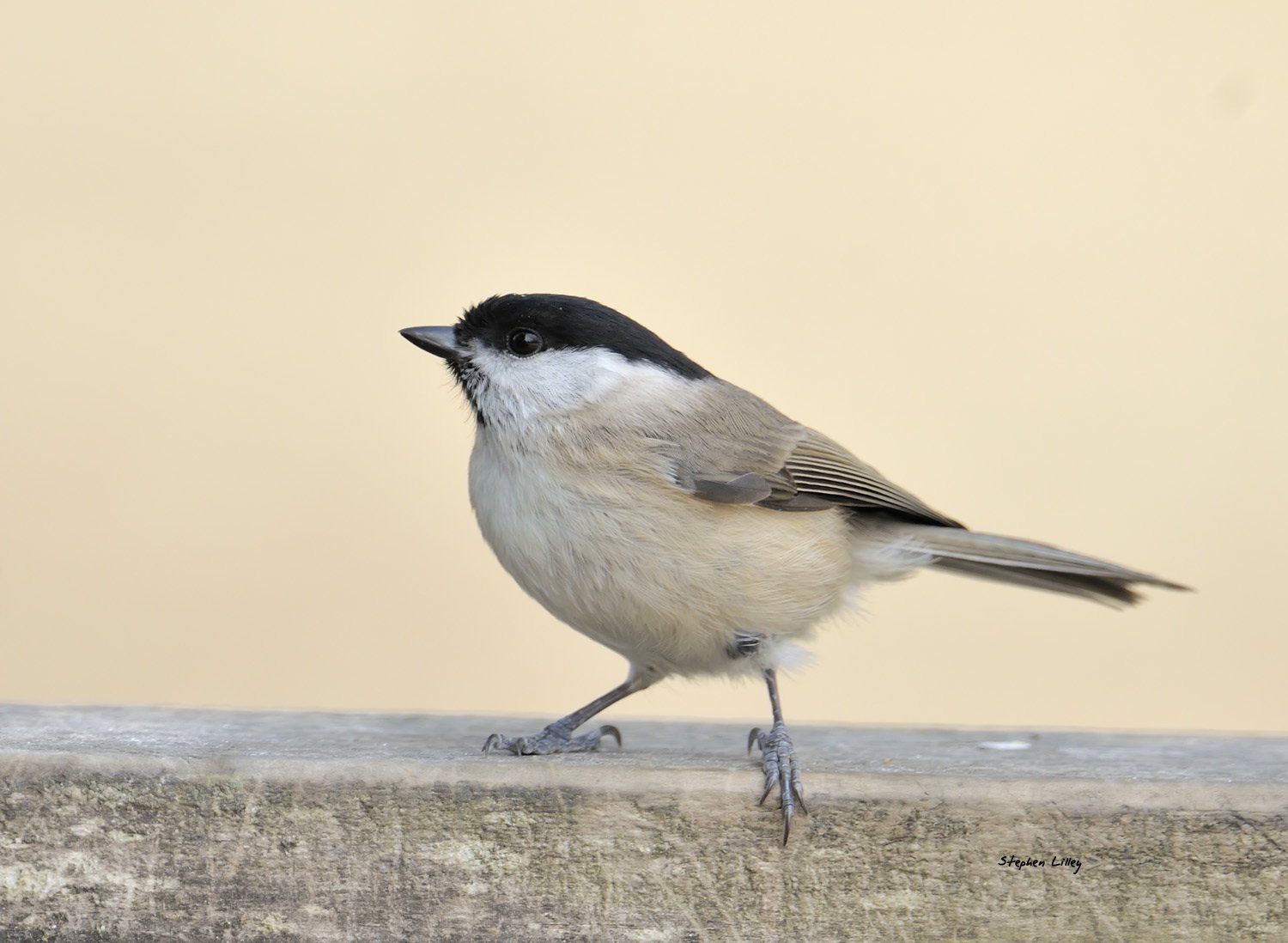
Marsh Tit (left) and Willow Tit (right). Photos by Stephen Lilley and Brian Vickers
